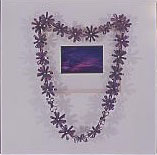

  |
||
 Afio Mai Series- Sunset at 619 I, 2003
Digital print, tracing paper, shell 65 x 47 x 11 cm Courtesy of the artist |
Born 1959, West Auckland, New Zealand; lives in
Auckland, New Zealand
“By combining iconic forms and distinctly urban ‘non-Pacific’ materials, my intent is to create a visual representation of what it means to me to be of a Pacific descent, living in Aotearoa [New Zealand] today.” Hastings-McFall uses unconventional materials, including found objects, to update the tradition of the lei. In Too Much Sushi VI, VII and VIII she hand-threaded lei from hundreds of small plastic fish bottles used to contain soy sauce in Japanese restaurants in New Zealand. Here the artist identifies with her Polynesian ancestry while at the same time acknowledging her upbringing and residency in Auckland, New Zealand’s most cosmopolitan city. Afio Mai Series—Sunset at 619: I, II, III, IV, V and Sunset (afio mai means “welcome” in Samoan) addresses her family’s Samoan and Palagi (non-Islander) backgrounds. This work consists of a series of framed photographs of sunsets of Auckland draped in lei, each made from duplicates of the photographs delicately cut, folded, and strung together to resemble flowers. The artist inherited the photographic negatives from her European grandfather. By reprinting her grandfather’s old photographs, framing them, and then draping them in lei, following the Polynesian custom of draping lei over photographs of loved ones, Hastings-McFall creates a hybrid memorial to her European grandfather. Nuclear Rosary Series- Black Rain III |